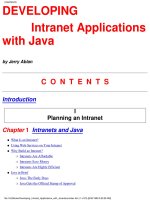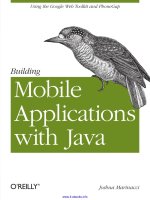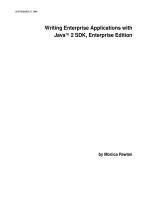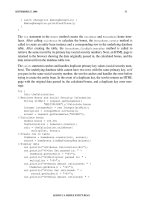Writing Enterprise Applications with Java™ 2 SDK, Enterprise Edition phần 5 pdf
Bạn đang xem bản rút gọn của tài liệu. Xem và tải ngay bản đầy đủ của tài liệu tại đây (30.92 KB, 12 trang )
LESSON 3 COOPERATING ENTERPRISE BEANS
46 SEPTEMBER 27, 2000
Change the Session Bean
In this lesson and as shown in Figure 14, the entity bean is a client of the session bean. This
means the entity bean gets its data from the session bean instead of from
BonusServlet as it
did in Lesson 2 A Simple Entity Bean (page 27). So, the
calcBonus method in the session
bean is modified to take the social security number as a parameter and create the entity bean.
Figure 14 Beans Working Together
CalcHome
The CalcHome interface is unchanged. It has the same create method that returns an
instance of the remote interface.
package Beans;
import java.rmi.RemoteException;
import javax.ejb.CreateException;
import javax.ejb.EJBHome;
public interface CalcHome extends EJBHome {
public Calc create()
throws CreateException, RemoteException;
}
Session Bean
(Application Server)
calcBonus method
getRecord method
Database
HTML Form
Browser
bonus.html
Servlet
(Web Server)
BonusServlet.class
Entity Bean
LESSON 3 COOPERATING ENTERPRISE BEANS
SEPTEMBER 27, 2000 47
Calc
The calcBonus method in the Calc interface is changed to take the social security number as
a parameter. This is so
CalcBean can pass the bonus and social security number to the entity
bean after calculating the bonus value. A new
getRecord method is added so CalcBean can
find an entity bean by its primary key (the social security number).
Also, the
calcBonus method signature throws DuplicateKeyException and CreateExcep-
tion
. This is so BonusServlet can catch and handle either of these exception conditions.
DuplicateKeyException descends from CreateException. If you design the calcBonus
method to throw DuplicateKeyException, but catch CreateException, DuplicateKeyEx-
ception
is not thrown. The way around this is to have calcBonus throw both Dupli-
cateKeyException
and CreateException.
package Beans;
import javax.ejb.EJBObject;
import java.rmi.RemoteException;
import javax.ejb.DuplicateKeyException;
import javax.ejb.CreateException;
public interface Calc extends EJBObject {
public Bonus calcBonus(int multiplier,
double bonus,
String socsec)
throws RemoteException,
DuplicateKeyException,
CreateException;
public Bonus getRecord(String socsec)
throws RemoteException;
}
CalcBean
The code to create the entity bean is moved from BonusServlet to the calcBonus method so
the bonus and social security number can be written to the entity bean after the bonus is cal-
culated. The
homebonus variable is an instance variable so it can be used in the calcBonus
method to look up the entity bean and in the getRecord method to locate the entity bean cor-
responding to the social security number.
package Beans;
import java.rmi.RemoteException;
import javax.ejb.SessionBean;
import javax.ejb.SessionContext;
LESSON 3 COOPERATING ENTERPRISE BEANS
48 SEPTEMBER 27, 2000
import javax.naming.InitialContext;
import javax.rmi.PortableRemoteObject;
import javax.ejb.DuplicateKeyException;
import javax.ejb.CreateException;
public class CalcBean implements SessionBean {
BonusHome homebonus;
//Throw DuplicateKeyException and CreateException
//so BonusServlet can catch and handle these
//exception conditions.
public Bonus calcBonus(int multiplier,
double bonus, String socsec)
throws DuplicateKeyException,
CreateException {
Bonus theBonus = null;
double calc = (multiplier*bonus);
try {
InitialContext ctx = new InitialContext();
Object objref = ctx.lookup("bonus");
homebonus = (BonusHome)
PortableRemoteObject.narrow(
objref, BonusHome.class);
} catch (Exception NamingException) {
NamingException.printStackTrace();
}
//Store data in entity bean
try {
theBonus = homebonus.create(calc, socsec);
} catch (java.rmi.RemoteException e) {
String message = e.getMessage();
e.printStackTrace();
}
return theBonus;
}
public Bonus getRecord(String socsec) {
Bonus record = null;
//Use primary key to retrieve data from entity bean
try {
record = homebonus.findByPrimaryKey(socsec);
} catch (java.rmi.RemoteException e) {
String message = e.getMessage();
} catch (javax.ejb.FinderException e) {
e.printStackTrace();
}
return record;
}
public void ejbCreate() { }
LESSON 3 COOPERATING ENTERPRISE BEANS
SEPTEMBER 27, 2000 49
public void setSessionContext(
SessionContext context){
}
public void ejbRemove() { }
public void ejbActivate() { }
public void ejbPassivate() { }
public void ejbLoad() { }
public void ejbStore() { }
}
Change the Servlet
The BonusServlet program is very similar to the version in Lesson 2 A Simple Entity Bean
(page 27) with changes in the
init and doGet methods. The init method for this lesson
looks up the
CalcBean session bean only.
public class BonusServlet extends HttpServlet {
CalcHome homecalc;
//Need Bonus variables because CalcBean methods
//called in the doGet method return instances
//of type Bonus
Bonus theBonus, record;
public void init(ServletConfig config)
throws ServletException{
try {
InitialContext ctx = new InitialContext();
Object objref = ctx.lookup("calcs");
homecalc = (CalcHome)
PortableRemoteObject.narrow(
objref, CalcHome.class);
} catch (Exception NamingException) {
NamingException.printStackTrace();
}
}
The try statement in the doGet method calculates the bonus, creates the session bean home
interface, and calls the
calcBonus and getRecord methods. If the methods successfully
complete, an HTML page is returned showing the data retrieved from the entity bean. If
DuplicateKeyException is thrown by the calcBonus method, an HTML page is returned
showing the social security number and multiplier passed in, and the exception message,
Duplicate primary key.
As before in Lesson 2 A Simple Entity Bean (page 27), the
catch statement catches and
handles duplicate primary key values (social security numbers).
LESSON 3 COOPERATING ENTERPRISE BEANS
50 SEPTEMBER 27, 2000
try {
Calc theCalculation;
//Retrieve Bonus and Social Security Information
String strMult = request.getParameter(
"MULTIPLIER");//Calculate bonus
Integer integerMult = new Integer(strMult);
multiplier = integerMult.intValue();
socsec = request.getParameter("SOCSEC");
//Calculate bonus
double bonus = 100.00;
theCalculation = homecalc.create();
//Call session bean
//Pass 3 parameters:multiplier, bonus, and socsec
theBonus = theCalculation.calcBonus(
multiplier, bonus, socsec);
record = theCalculation.getRecord(socsec);
//Display data returned by session bean
out.println("<H1>Bonus Calculation</H1>");
out.println("<P>Soc Sec retrieved: " +
record.getSocSec() + "<P>");
out.println("<P>Bonus Amount retrieved: " +
record.getBonus() + "<P>");
out.println("</BODY></HTML>");
} catch (javax.ejb.DuplicateKeyException e) {
String message = e.getMessage();
out.println("<H1>Bonus Calculation</H1>");
out.println("<P>Soc Sec passed in: " + socsec +
"<P>");
out.println("<P>Multiplier passed in: " +
multiplier + "<P>");
out.println("</BODY></HTML>");
} catch (Exception CreateException) {
CreateException.printStackTrace();
}
Compile
First, compile the session bean and servlet. Refer to Lesson 1 for path and classpath settings,
and information on where to place the source files.
LESSON 3 COOPERATING ENTERPRISE BEANS
SEPTEMBER 27, 2000 51
Compile the Session Bean
Unix
#!/bin/sh
cd /home/monicap/J2EE
J2EE_HOME=/home/monicap/J2EE/j2sdkee1.2.1
CPATH=.:$J2EE_HOME/lib/j2ee.jar
javac -d . -classpath "$CPATH" Beans/CalcBean.java
Beans/CalcHome.java Beans/Calc.java
Windows
cd \home\monicap\J2EE
set J2EE_HOME=\home\monicap\J2EE\j2sdkee1.2.1
set CPATH=.;%J2EE_HOME%\lib\j2ee.jar
javac -d . -classpath %CPATH% Beans/CalcBean.java
Beans/CalcHome.java Beans/Calc.java
Compile the Servlet
Unix:
cd /home/monicap/J2EE/ClientCode
J2EE_HOME=/home/monicap/J2EE/j2sdkee1.2
CPATH=.:$J2EE_HOME/lib/j2ee.jar:
/home/monicap/J2EE
javac -d . -classpath "$CPATH" BonusServlet.java
Windows:
cd \home\monicap\J2EE\ClientCode
set J2EE_HOME=\home\monicap\J2EE\j2sdkee1.2 set
CPATH=.;%J2EE_HOME%\lib\j2ee.jar:\home\monicap\J2EE
javac -d . -classpath %CPATH% BonusServlet.java
Start the Platform and Tools
To run this example, you need to start the J2EE server, the Deploy tool, and Cloudscape
database. In different windows, type the following commands:
j2ee -verbose
deploytool
cloudscape -start
If that does not work, type this from the J2EE directory:
LESSON 3 COOPERATING ENTERPRISE BEANS
52 SEPTEMBER 27, 2000
Unix
j2sdkee1.2.1/bin/j2ee -verbose
j2sdkee1.2.1/bin/deploytool
j2sdkee1.2.1/bin/cloudscape -start
Windows
j2sdkee1.2.1\bin\j2ee -verbose
j2sdkee1.2.1\bin\deploytool
j2sdkee1.2.1\bin\cloudscape -start
Assemble the Application
The steps for this section include the following:
• Create New J2EE Application
• Create New Web Component
• Bundle Session and Entity Beans in One JAR File
Create New J2EE Application
Rather than update the J2EE application from Lessons 1 and 2, these steps create a new
J2EE application.
Delete
BonusApp:
• Click BonusApp so it is highlighted
• Select Delete from the Edit menu
Create
2BeansApp:
• From the File menu, select New Application.
• Click the right mouse button in the Application Display Name field.
2BeansApp
appears as the display name.
• Click the Browse button to open the file chooser to select the location where you want
the application
EAR file to be saved.
New Application file chooser:
• Locate the directory where you want to place the application
EAR file
• In this example, that directory is
/export/home/monicap/J2EE.
• In the File name field, type
2BeansApp.ear.
LESSON 3 COOPERATING ENTERPRISE BEANS
SEPTEMBER 27, 2000 53
• Click New Application.
• Click OK.
Create New Web Component
Now, go through the steps to create the WAR file. These steps are outlined in Lesson 1 and
summarized below. With 2BeansApp selected,
File Menu:
• Select
New Web Component.
Introduction:
• Read and Click
Next
War File General Properties:
• Specify BonusWar for the display name.
• Click Add
• Go to the
ClientCode directory and add bonus.html
• Click Next
• Go to the ClientCode directory and add BonusServlet.class
• Click Finish.
War File General Properties:
• Click
Next.
Choose Component Type:.
• Make sure
Describe a servlet is selected.
• Click
Next.
Component General Properties:
• Make
BonusServlet the servlet class
• Make the display name
BonusServlet.
• Click
Next.
Component Initialization Parameters.
• Click
Next.
Component Aliases:
• Specify
BonusAlias
• Click Finish.
LESSON 3 COOPERATING ENTERPRISE BEANS
54 SEPTEMBER 27, 2000
Inspecting window:
• Select Web Context
• Specify
BonusRoot.
Bundle Session and Entity Beans in one JAR File
In this lesson, you will put both the session and entity beans in the same JAR file. To do this,
you first create the JAR file with only the session bean in it, and then add the entity bean to
that JAR file.
Create JAR with Session Bean
With
2BeansApp selected,
File Menu:
• Select
New Enterprise Bean
Introduction:
• Read and click
Next.
EJB JAR:
• Make sure
2BeansApp shows in the Enterprise Bean will go in field.
• Specify
2BeansJar as the display name.
• Click
Add (the one next to the Contents window).
• Toggle the directory so the Beans directory displays with its contents.
• Select
Calc.class
• Click Add.
• Select
CalcBean.class
• Click Add.
• Select
CalcHome.class
• Click Add.
Enterprise Bean JAR classes:
• Make sure you see
Beans/Calc.class, Beans/CalcHome.class, and Beans/Cal-
cBean.class
in the display.
• Click
OK.
EJB JAR:
• Click
Next.
LESSON 3 COOPERATING ENTERPRISE BEANS
55 SEPTEMBER 27, 2000
General:
•
CalcBean is the classname, Beans.CalcHome is the Home interface, and Beans.Calc
is the Remote interface.
• Enter
CalcBean as the display name.
• Click session and stateless.
• Click
Next.
Environment Entries:
• Click
Next. This simple session bean does not use properties (environment entries).
Enterprise Bean References:
• lick
Next. The references are handled during deployment rather than here.
Resource References:
• Click
Next. Thissimple sessionbean doesnot lookup adatabase orJavaMail session
object.
Security:
• Click
Next. This simple session bean does not use security roles.
Transaction Management:
• Select
Container-managed transactions (if it is not already selected).
• In the list below make
calcBonus, and getRecord required. This means the container
starts a new transaction before running these methods. The transaction commits just
before the methods end. You can find more information on these transaction settings
in Chapter 6 of the Enterprise JavaBeans Developer's Guide.
• Click Next.
Review Settings:
• Click
Finish.
Local Applications:
• Select
2BeansApp.
• In the Inspecting window, select
JNDI names,giveCalcBean the JNDI name of calcs,
and press the Return key.
Add the Entity Bean
With
2BeansApp selected,
File Menu:
LESSON 3 COOPERATING ENTERPRISE BEANS
56 SEPTEMBER 27, 2000
• Select New Enterprise Bean
Introduction:
• Read and click
Next.
EJB JAR:
• Make sure
2BeansJar shows in the Enterprise Bean will go in field. This setting will
add the new bean to the existing JAR file instead of putting the new bean in its own
JAR file.
• Click
Add (the one next to the Contents window).
• Toggle the directory so the Beans directory displays with its contents.
• Select
Bonus.class
• Click Add.
• Select
BonusBean.class
• Click Add.
• Select
BonusHome.class
• Click Add.
Enterprise Bean JAR classes:
• Make sure you see
Beans/Bonus.class, Beans/BonusHome.class, and Beans/
BonusBean.class
in the display.
• Click
OK.
EJB JAR:
• Click
Next.
General:
• Make sure
Beans.BonusBean is the classname, Beans.BonusHome is the Home inter-
face, and
Beans.Bonus is the Remote interface.
• Enter
BonusBean as the display name.
• Click Entity.
• Click
Next.
Entity Settings:
• Select
Container managed persistence.
• n the window below, check
bonus and socsec. The primary key class is
java.lang.String, and the primary key field name is socsec. Note that the primary
key has to be a class type. Primitive types are not valid for primary keys.
• Click
Next.
LESSON 3 COOPERATING ENTERPRISE BEANS
57 SEPTEMBER 27, 2000
Environment Entries:
• Click
Next. This simple entity bean does not use properties (environment entries).
Enterprise Bean References:
• Click
Next. This simple entity bean does not reference other enterprise Beans.
Resource References:
• Click
Next. This simple entity bean does not look up a database or JavaMail session
object.
Security:
• Click
Next. This simple entity bean does not use security roles.
Transaction Management:
• Select
Container-managed transactions (if it is not already selected).
• In the list below make
create, findByPrimaryKey, getBonus and getSocSec
required. This means the container starts a new transaction before running these meth-
ods. The transaction commits just before the methods end. You can find more informa-
tion on these transaction settings in Chapter 6 of the Enterprise JavaBeans Developer's
Guide.
• Click
Next.
Review Settings:
• Click
Finish.
Local Applications:
• Select
2BeansApp.
• In theInspecting window,select
JNDI names,giveBonusBean the JNDI name of bonus
and CalcBean the JNDI name of calcs
• Press the Return key after each entry.
Before the J2EE application can be deployed, you need to specify deployment settings for
the entity bean and generate the SQL. Here is how to do it:
Local Applications window:
• Select
BonusBean.
Inspecting window:
• Select
Entity
• Click the Deployment Settings button to the lower right.
Deployment Settings window:









